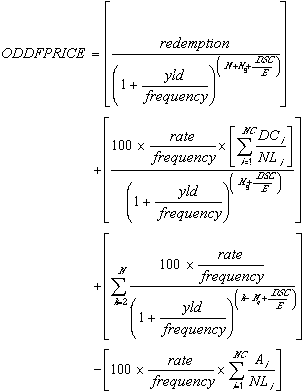ODDFPRICE
Returns the price per $100 face value of a security having an odd (short or long) first period.
If this function is not available, run the Setup program to install the Analysis ToolPak. After you install the Analysis ToolPak, you must enable it by using the Add-Ins command on the Tools menu.
Syntax
ODDFPRICE(settlement,maturity,issue,first_coupon,rate,yld,redemption,frequency,basis)
Settlement is the security's settlement date. The security settlement date is the date after the issue date when the security is traded to the buyer.
Maturity is the security's maturity date. The maturity date is the date when the security expires.
Issue is the security's issue date.
First_coupon is the security's first coupon date.
Rate is the security's interest rate.
Yld is the security's annual yield.
Redemption is the security's redemption value per $100 face value.
Frequency is the number of coupon payments per year. For annual payments, frequency = 1; for semiannual, frequency = 2; for quarterly, frequency = 4.
Basis is the type of day count basis to use.
|
Basis |
Day count basis |
|
|
|
0 or omitted |
US (NASD) 30/360 |
|
1 |
Actual/actual |
|
2 |
Actual/360 |
|
3 |
Actual/365 |
|
4 |
European 30/360 |
Remarks
- The settlement date is the date a buyer purchases a coupon, such as a bond. The maturity date is the date when a coupon expires. For example, suppose a 30-year bond is issued on January 1, 1996, and is purchased by a buyer six months later. The issue date would be January 1, 1996, the settlement date would be July 1, 1996, and the maturity date would be January 1, 2026, which is 30 years after the January 1, 1996, issue date.
- Settlement, maturity, issue, first_coupon, and basis are truncated to integers.
- If any argument is nonnumeric, ODDFPRICE returns the #VALUE! error value.
- If settlement, maturity, issue, or first_coupon is not a valid date, ODDFPRICE returns the #NUM! error value.
- If rate < 0 or if yld < 0, ODDFPRICE returns the #NUM! error value.
- If basis < 0 or if basis > 4, ODDFPRICE returns the #NUM! error value.
- The following date condition must be satisfied; otherwise, ODDFPRICE returns the #NUM! error value:
maturity > first_coupon > settlement > issue
- ODDFPRICE is calculated as follows:
Odd short first coupon:

Where:
A = number of days from the beginning of the coupon period to the settlement date (accrued days).
DSC = number of days from the settlement to the next coupon date.
DFC = number of days from the beginning of the odd first coupon to the first coupon date.
E = number of days in the coupon period.
N = number of coupons payable between the settlement date and the redemption date. (If this number contains a fraction, it is raised to the next whole number.)
Odd long first coupon:

Where:
Ai = number of days from the beginning of the ith, or last, quasi-coupon period within odd period.
DCi = number of days from dated date (or issue date) to first quasi-coupon (i = 1) or number of days in quasi-coupon (i = 2, ..., i = NC).
DSC = number of days from settlement to next coupon date.
E = number of days in coupon period.
N = number of coupons payable between the first real coupon date and redemption date. (If this number contains a fraction, it is raised to the next whole number.)
NC = number of quasi-coupon periods that fit in odd period. (If this number contains a fraction, it is raised to the next whole number.)
NLi = normal length in days of the full ith, or last, quasi-coupon period within odd period.
Nq = number of whole quasi-coupon periods between settlement date and first coupon.
Example
A treasury bond has the following terms:
November 11, 1986, settlement date
March 1, 1999, maturity date
October 15, 1986, issue date
March 1, 1987, first coupon date
7.85 percent coupon
6.25 percent yield
$100 redemptive value
Frequency is semiannual
Actual/actual basis
The price per $100 face value of a security having an odd (short or long) first period (in the 1900 date system) is:
ODDFPRICE("11/11/86","3/1/99","10/15/86","3/1/87",0.0785,0.0625,100,2,1) equals 113.597717

